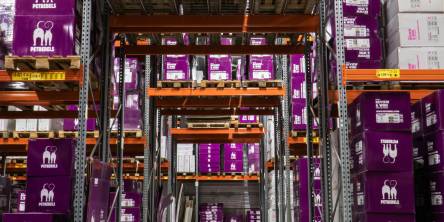Asset Management Software: Benefits for Manufacturing Sector

The manufacturing sector, without a doubt, is one of the most crucial parts of the global economy. After all, they not only serve end customers but countless other industries and businesses. So you can imagine that any issue for a manufacturing company can have grave consequences on the entire market. Case in point, the recent global chips shortage. Now, considering its vital role, the industry has sought out modern tools to help ensure it can operate as seamlessly as possible. Of course, the market has plenty of options to offer, but none quite as important as asset management solutions.
Asset management when applied to manufacturing or process plants covers taking stock of the entire lifecycle of plant asset elements, including equipment, parts, production lines, and the plant buildings. And, to make decisions about the use of the asset, related investment and disinvestment policies, and portfolio management.
The software to manage asset management helps manufacturing organizations in several ways. Beyond supporting to increase asset life & productivity, it enables easily tracking & upkeep of expenses by preventing and foresee of asset failures, decrease expensive downtime, ensure compliance, and further lower the total expense of upkeep. I’ll discuss them in detail below.
The manufacturing sector, without a doubt, is one of the most crucial parts of the global economy. After all, they not only serve end customers but countless other industries and businesses. So you can imagine that any issue for a manufacturing company can have grave consequences on the entire market. Case in point, the recent global chips shortage. Now, considering its vital role, the industry has sought out modern tools to help ensure it can operate as seamlessly as possible.Here are some of its benefits to help you understand why they are so popular among manufacturing companies.
- Improved asset performance: The biggest USP of asset management software is its ability to empower manufacturing companies to affect generous reductions in their costs of labor and other relevant costs. It does so by streamlining processes as well as helping companies glean the best possible value from their assets. Then there are all the analytics and reports that further contribute to enhanced asset performance.
- Prevent asset failure: Any company that relies on assets, especially at the scale that manufacturing companies do, understands just how costly asset failure and downtime for even a single piece of equipment can prove to be. And let us not forget the fact that it also takes a toll on the company’s processes and overall operations. This challenge can be tended to via asset management software, thanks to their ability to set up maintenance schedules, send out alerts, monitor asset performance, etc. These factors ensure assets are well maintained, thus minimizing the scope of failure.
- Improved analytics: Asset management software offer a unified dashboard, via which requisite personnel can access a plethora of reports, critical information about assets, how all the information is linked, and much more. Access to such high-quality data about various aspects of the company’s assets enables companies to run extensive analyses that deliver substantially improved levels of reports and insights. What do such reports contribute to the business? Plenty, actually; including improved decision-making process among other things.
- Asset maintenance: We will round off this list with yet another vital advantage that asset management solutions bring to the table for this sector. They allow companies to monitor asset performance, purchase of spare parts, every single assets’ expenses, downtime, work orders for maintenance, and other such relevant factors. This data, when analyzed, provides valuable insights into the upkeep and maintenance requirements of the company’s assets. Timely maintenance, in turn, helps companies save humongous amounts of money they would otherwise spend on their repair and prevent major downtimes.
It is quite evident that asset management solutions have come to play a vital role in the manufacturing industry. Thanks to the increased adoption of such avant-garde software and tools for the proper management and upkeep of the manufacturing sector’s assets, companies operating in this space have gained a variety of benefits.
Manufacturing companies are now better positioned to keep a close eye on their assets and their performance, implement predictive maintenance to enhance assets’ lifecycles, and ensure compliance with required standards and regulations. Suffice it to say that there is much to be gained for any company that has the capacity to undertake manufacturing software development for their assets.
Similar Articles
For modern businesses to thrive, ensuring the effective management of inventory stands has become vitally important. Inventory management stands as a cornerstone of success. And the emergence of the Internet of Things (IoT) has introduced a new era of connectivity and efficiency across diverse industries.
Do you know what the following e-commerce companies have in common: Amazon, Walmart, eBay, and more? All of these e-commerce companies' apps make use of Java. Java is decidedly among the leading choices of programming language for e-commerce applications because it offers a world of benefits; for example, since Java code can be run on any platform with a Java Virtual Machine (JVM), users of e-commerce apps made with Java can access the said apps on a variety of devices.
Nikola Tesla in 1926, once described what is now called a mobile phone as a telephone that can fit into one's “vest pocket.” As otherworldly as that idea was then, nearly a century later, the reality is even more astounding.
Given the staggeringly high amounts of data being generated worldwide every single day, it ought to come as no surprise that organizations often struggle to pick the right tools to help them effectively harness the potential of all their data.
Managing properties can be a difficult task with the right tools. Property owners must find and use the best property management software. It can be a long and tedious process as there are many options in the property management software market.
In the ever-evolving financial services landscape, industry challenges are numerous and complex. From stringent regulations to rapidly advancing technology and changing consumer expectations, financial institutions face many obstacles.
The human learning capability is a great resource for helping technology evolve and grow, breaking boundaries, and creating new ones. Emulating the ability of humans to learn at a gradual but retentive pace, Machine Learning is the latest power monster that is redefining human-machine interaction.
In the ever-evolving landscape of low-code development, Microsoft's Power Platform stands out as a powerful tool for building custom applications. In today's dynamic digital landscape, creating and managing web pages is no longer the exclusive realm of professional web developers
In the data-driven business world, where information is of utmost priority, organizations are increasingly turning to data warehousing and data marts to harness the power of their data. These data management solutions are pivotal in transforming raw data into actionable insights.









